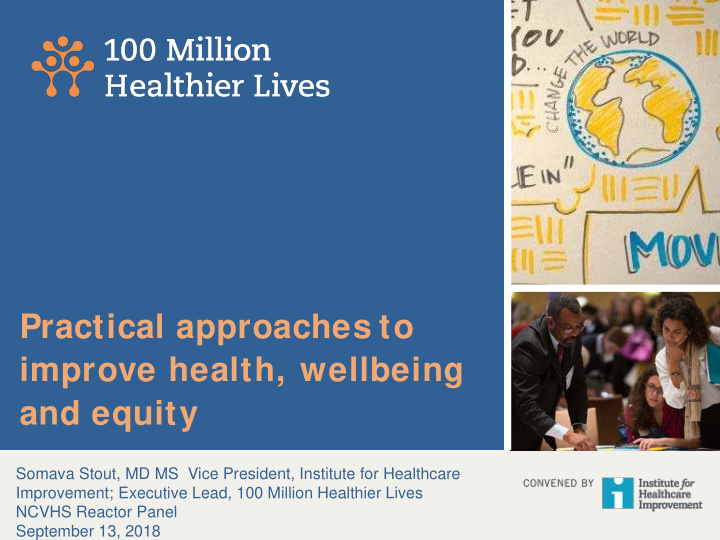



Practical approaches to improve health, wellbeing and equity Somava Stout, MD MS Vice President, Institute for Healthcare Improvement; Executive Lead, 100 Million Healthier Lives NCVHS Reactor Panel September 13, 2018
100 Million Healthier Lives Who: An unprecedented collaboration of change agents pursuing an unprecedented result: 100 million people living healthier lives by 2020 Vision: to fundamentally transform the way we think and act to improve health, wellbeing and equity. Equity is the price of admission. www.100mlives.org
Movement: >1850 members in 30+ countries worldwide who reach >500 million people Supporting hundreds of organizations across sectors in multiple states.
Listening today from three 4 perspectives An organization accompanying hundreds of communities, including 17 states, on the journey. The organization that is facilitating the federal- nonfederal process for identification of an ecosystem of measures to support the NCVHS framework for population health. • What can be implemented and useful at scale? Someone who has been personally supporting states and communities to develop equitable measurement systems for improvement.
Challenges and opportunities 5 Need for reliable, easily accessible (who can get to it? do they know it’s 1. there? is it understandable?), useful data at the community level. NCVHS framework process: there are differences in what people value 2. at the national and community level (though there are commonalities). Issues with variable data quality and loss of data that was used on the 3. one hand; on the other hand, an ocean of data housed in different places, not designed for the average end user “dying of thirst in an ocean of data” how might we prioritize and create insight? Need much more help for people to use data to drive improvement – 4. from “understand the world” to “change the world”? How might we make it easy for people to be able to easily collect and 5. analyze indicators to drive improvement at the local level in a standard and useful way which then contributes to a data “commons”? Partnerships! 6.
Reflections/takeaways 6 Unified data governance framework and “system” is needed for health data at the national level. Communities need support for analyzing the data and making it useful and customizable to local “non-data-expert” users so we can go from data to insight to action. Should this be seen as a common good? Reduce complexity, do a few things really well and seamlessly, get them to the hands of users in a way that is accessible, reliable, and useful. How can we integrate clinical and social determinant data together for people? How can we build equity as a standard rather than a “nice to have”? How can we spread knowledge of what is already possible?
Opportunity for testing what’s possible: NCVHS Framework emerging 7 recommendations Small set of topline measures that have emerged that are important for people at the national and community level and across contexts: • Wellbeing of people • Subjective wellbeing, life expectancy • Wellbeing of communities • Community health and wellbeing index based on the NCVHS domains (or CHRR calculation) • Equity (proposed: difference in wellbeing and life expectancy; racial segregation, high school graduation, income inequality) Branching set of recommended measures in each NCVHS framework domain/subdomain for those who want to improve a particular area – expand out and customizable for communities. What would need to come together to create this as a useful resource to communities? How can it be supported as a common resource?
Recommend
More recommend